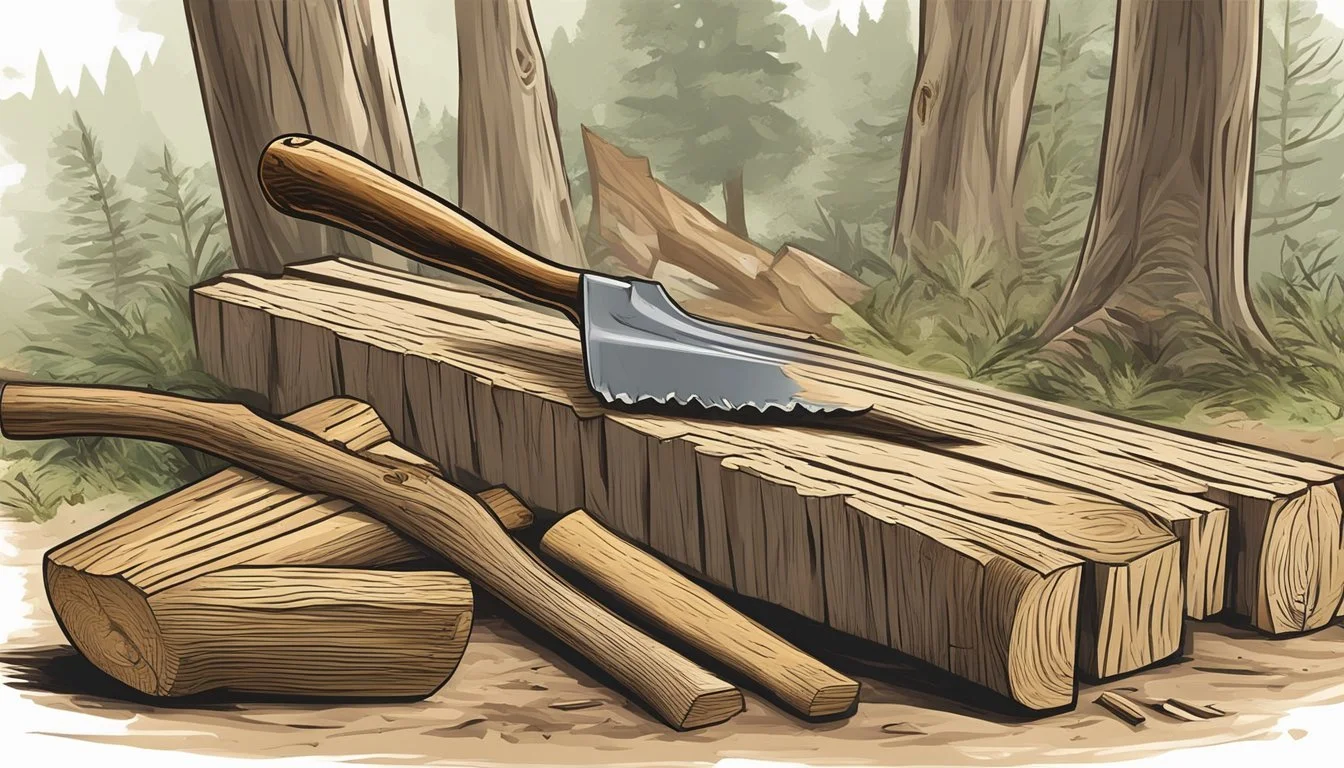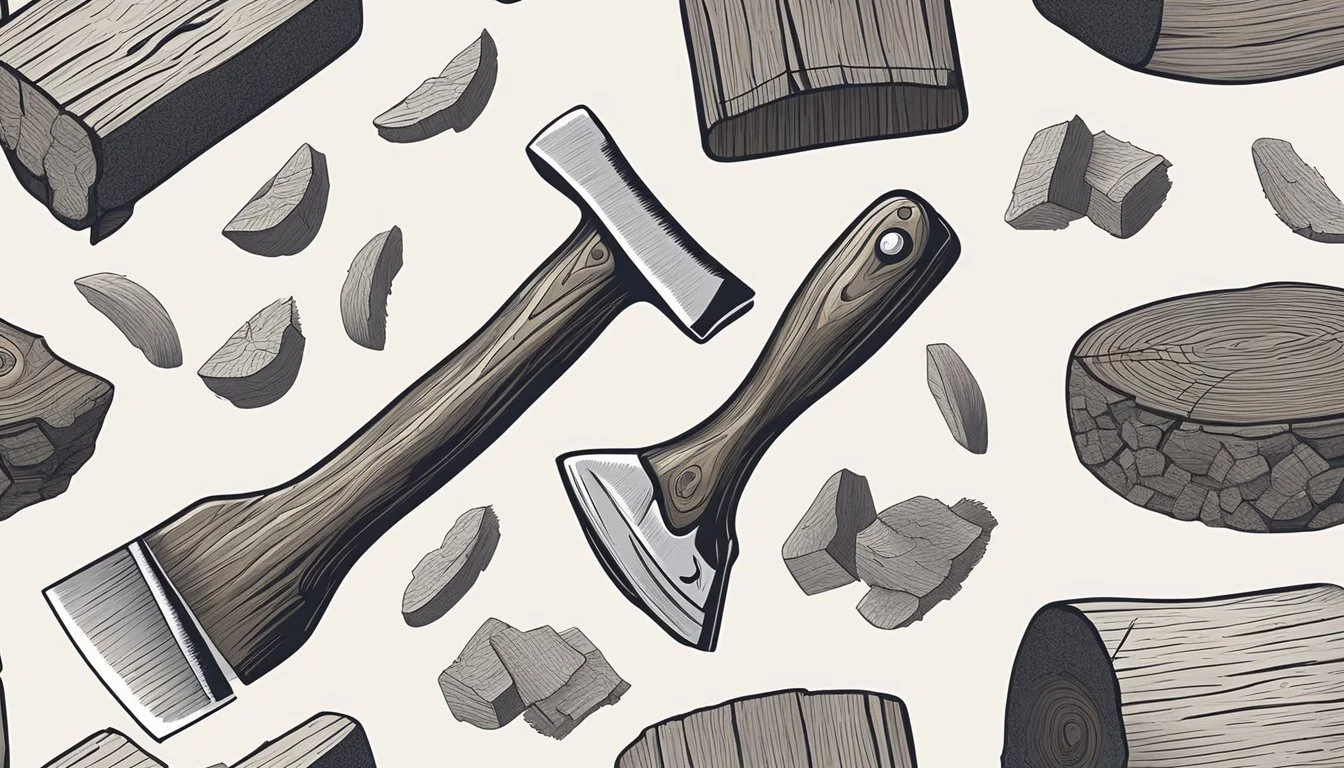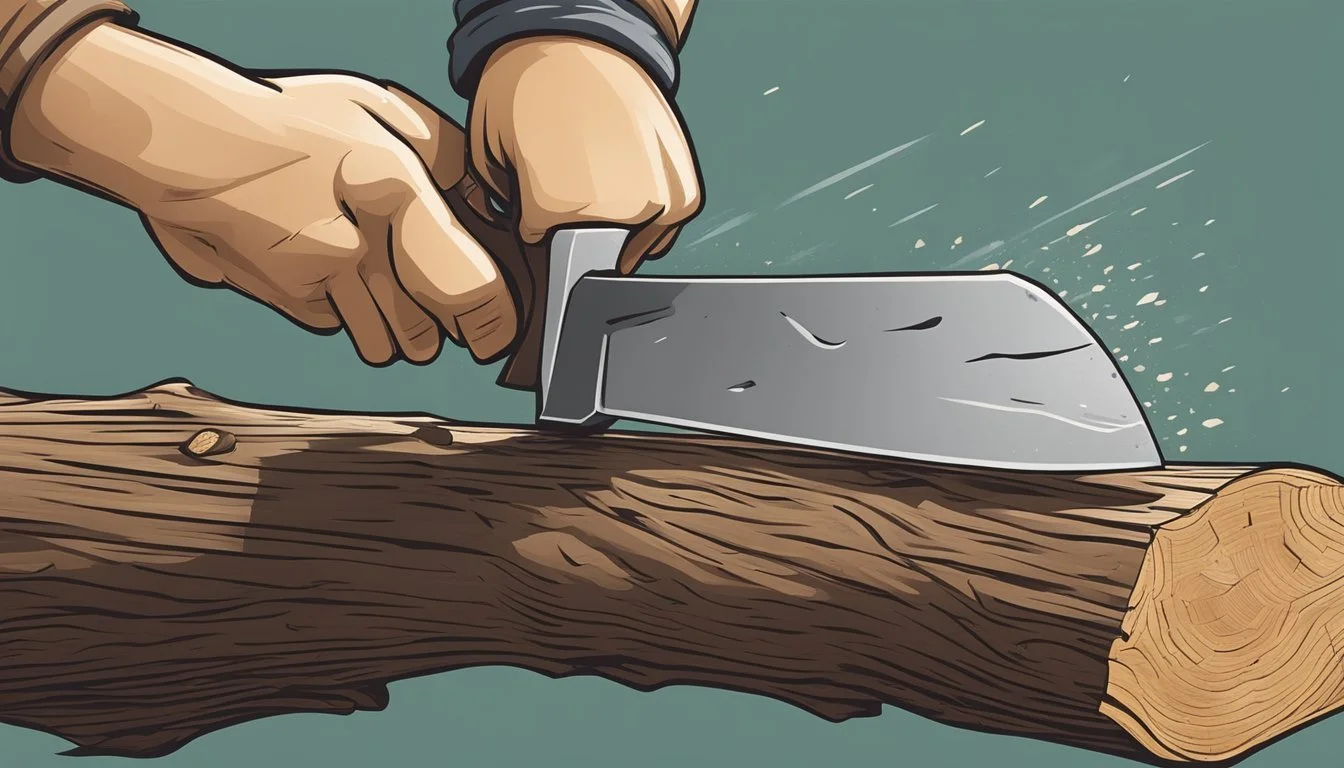The Benefits of Using a Hatchet for Precise Homesteading Tasks
A Tool for Efficiency and Accuracy
A hatchet, with its compact form and sharp blade, emerges as an essential tool in the homesteader's arsenal, particularly for those precise tasks where accuracy and control are paramount. Unlike larger axes, the hatchet is designed for one-handed use, making it notably easier to maneuver for detailed work such as shaping, trimming, and splitting small to medium-sized logs for kindling. The balance between the weight and the power it can deliver proves advantageous for precision jobs that require both finesse and force.
For homesteaders, the diversity of tasks at hand calls for tools that can offer versatility without sacrificing performance. The hatchet fits this need well, being not just a chopping instrument but also a tool for carving and crafting wood. Its design often includes a flat opposite side that can be used for hammering, making it a multifunctional item that conserves space and weight in the toolbox. Considering the range of uses and the control it affords, the hatchet stands out as a go-to implement for precise tasks around the homestead.
The Hatchet Defined
In the realm of homesteading, a hatchet is a vital tool known for its precision and ease of use. This section provides detailed insights into the hatchet's anatomy, the variety of hatchets available, how they compare to an ax, guidelines for selection, maintenance best practices, and essential safety measures.
Anatomy of a Hatchet
A hatchet consists of two main components: the handle and the blade. The handle is typically made from sturdy materials like wood or fiberglass, designed to fit comfortably in the hand for control and leverage. The blade, forged from high-quality steel, features a sharp edge for cutting and a flat opposite side that can be used for pounding.
Types of Hatchets and Their Uses
There are several types of hatchets, each suited to specific tasks:
Camping Hatchet: Compact and lightweight, ideal for survival and bushcraft;
Gardening Hatchet: Smaller with a precise edge for gardening tasks;
Splitting Hatchet: A heavier head for splitting kindling and small logs.
Comparing Hatchet and Ax
The hatchet distinguishes itself from an ax through its size and handle length. Hatchets are smaller, with shorter handles, enabling one-handed use and greater control for detailed tasks. In contrast, an ax is larger, designed for two-handed grips, and provides greater leverage for felling trees.
Selecting the Right Hatchet
Consider the hatchet's balance, weight, and grip when selecting. A well-balanced hatchet ensures precision, a comfortable weight allows for extended use without fatigue, and a secure grip provides safety and control.
Maintaining Your Hatchet
Regular maintenance ensures the longevity and effectiveness of your hatchet:
Sharpening: Use a sharpening stone with a small amount of oil to hone the edge;
Cleaning: Keep the blade and handle free from dirt and debris.
Safety Measures
When using a hatchet, practice the following safety tips:
Wear appropriate safety equipment like gloves and eye protection;
Use a steady grip to prevent slipping;
Always chop away from your body;
Ensure no one is within the swing radius.
By understanding and applying these principles, one can use a hatchet with confidence and precision on their homestead.
Homestead Tasks Optimized by Hatchets
A hatchet stands out as an indispensable tool for homesteaders, merging the benefits of precision and size with the efficiency needed for various tasks. From chopping wood to intricate garden work and maintaining land, a hatchet brings balance and accuracy that larger tools cannot match.
Chopping Wood Efficiently
For homesteaders, chopping wood is a routine yet critical task, primarily when preparing firewood and kindling for a fireplace. The hatchet's compact size allows for swift, controlled strikes, making it ideal for quickly turning larger wood pieces into smaller, usable sizes for efficient burning.
Precision Work in Gardening
In the garden, a hatchet can perform tasks typically reserved for pruning shears but with added heft. Precision work such as trimming branches and cutting small trees or shrubs can be done with the hatchet's blade, providing the accuracy needed without sacrificing speed.
Building and Repairing Structures
Hatchets serve well in carpentry and construction applications on a homestead. Their balanced weight makes them adept at tasks requiring a sharp, durable tool for cutting and shaping wooden materials used in building or repairing farm structures.
Land Management Strategies
Effective land management often involves clearing brush and creating trails. A hatchet's portability and sharpness are essential for homesteaders, allowing them to maneuver through landscaping challenges and forestry maintenance with confidence.
Outdoor Living Dynamics
Lastly, a hatchet is a valuable tool for those spending time outdoors beyond the boundaries of their homestead. Whether setting up camp in the wilderness or establishing new trails, a hatchet makes managing these environments more manageable, providing indispensable utility in remote settings.
Leveraging Hatchet in Survival Situations
In survival scenarios, a hatchet is not just a tool but a versatile ally. With its compact size and ability to perform tasks ranging from wood processing to self-defense, a hatchet becomes indispensable.
Essentials of Wilderness Survival
In the wilderness, survival hinges on the ability to perform essential tasks. A hatchet, providing a balance between size and efficacy, is crucial for procuring firewood and kindling. Its sharp, high-carbon steel blade enables users to efficiently split kindling and cut larger pieces of wood, necessary for maintaining warmth and cooking.
Bushcraft and the Hatchet
Bushcraft skills are enriched by the deployment of a hatchet, an exemplary bladed tool that simplifies complex tasks. Using a hatchet, one can proficiently carve wood, create tools, and clear brush, all integral to thriving in a natural environment. Its steel blade makes it durable and reliable for consistent use.
Examples of hatchet uses in bushcraft:
Carving notches for traps or shelters.
Crafting wooden utensils or modification of gear.
Campsite Management
A hatchet proves to be not only an armament but also a tool of meticulous campsite management. It's instrumental in camping situations for splitting firewood and hammering tent stakes, enhancing the ease and safety of establishing a camp. Its leverage makes it well-suited for tasks requiring controlled force.
Emergency Tools and Weapons
As a weapon, a hatchet's design is advantageous in emergencies. Its compact form allows for quick access and swift maneuverability. Versatile in nature, a hatchet can be used for both defensive and practical purposes, acting as a multi-functional tool crucial for any survivalist’s repertoire.
Defensive use: The hatchet can fend off wildlife threats.
Practical use: It can aid in breaking ice or cutting through obstacles if escape is necessary.
Physical and Mental Benefits of Hatchet Use
Using a hatchet for precise homesteading tasks offers notable physical and mental benefits. As a versatile tool, it facilitates exercise through manual labor and fosters a sense of self-reliance, while providing stress relief through routine tasks, and its affordability ensures long-term value.
Exercise and Manual Labor
Physical Benefits:
Exercise: Using a hatchet for chopping wood and splitting kindling constitutes a significant physical workout, engaging core and arm muscles.
Coordination: The necessity for accuracy in striking enhances hand-eye coordination and fine motor skills.
Self-Reliance and Empowerment
Mental Benefits:
Self-sufficiency: Mastering hatchet use for tasks around the farm provides a profound sense of independence.
Empowerment: The power to accomplish tasks with your own two hands boosts confidence and satisfaction.
Stress Relief Through Routine Tasks
Emotional Benefits:
Mindfulness: Focusing on the routine of chopping wood can have a meditative effect, promoting mental clarity and reducing stress.
Satisfaction: Completing manual labor with a hatchet can lead to a sense of accomplishment and personal contentment.
Affordability and Long-Term Value
Economic Benefits:
Cost-effective: Hatchets are generally more affordable than other tools, such as chainsaws.
Durability: A well-maintained hatchet, such as the robust X7 hatchet, can last for years, offering exceptional long-term value.
By incorporating the hatchet into homesteading tasks, individuals reap the benefits of a physically active lifestyle, the empowerment that comes with self-reliance, the therapeutic effects of stress relief through routine, and the economic advantages of a cost-effective and durable tool.
Integrating Hatchets into Everyday Homestead Life
Incorporating a hatchet into homestead duties ensures precision in tasks and economizes effort due to its tailored design for one-handed use and portability.
Implementation in Regular Chores
A hatchet is an indispensable piece of equipment for homestead chores. Its sharp blade and manageable size make it perfect for splitting kindling and cutting small logs with efficiency and precision. Regular chores like preparing firewood become simplified, as the hatchet lends itself well to tasks requiring less leverage than an axe.
Chore Efficiency:
Splitting kindling
Trimming branches
Crafting tools
Transporting and Storing the Hatchet
The compact nature of the hatchet allows for easy transportation, whether affixed to a belt loop during a camping trip or carried in a toolbox to a landscaping site. A hatchet's handle should be sheathed for safety, and storage can be as simple as hanging it on a shop wall or securing it in a pickup toolbox.
Transport Solutions:
Belt loops
Toolboxes
Backpacks
Storage Ideas:
Wall mounts
Sheaths
Shelves in sheds
Improving Gardening Tactics
Hatchets provide accuracy in gardening tasks, such as shaping garden beds or pruning plants. Their ease of handling and ability to make precise cuts with minimal damage to plant tissue is fundamental in sustainable gardening practices. Using a hatchet can lead to cleaner cuts, promoting plant health and vigorous growth.
Gardening Applications:
Shaping beds
Harvesting thick-stemmed vegetables
Enhancing Outdoor Activities
Beyond mere chores, hatchets are also suitable for a range of outdoor activities that require the crafting of tools or the precision in woodwork for survivalist shelters. The versatility of hatchets shines in outdoors and wilderness settings where building shelters, crafting stakes, and general campsite management are paramount.
Outdoor Uses:
Shelter building
Tool crafting
Stake creation
Using a hatchet within a homestead and beyond proves to be beneficial for those seeking reliable tools that accommodate a broad scope of precise tasks.
Tools and Accessories for the Hatchet
Hatchets serve as versatile tools in homesteading, excelling in precision tasks. Carefully selected accessories can augment their utility and longevity whilst enhancing user safety.
Essential Hatchet Complements
Sharpening Tools:
A well-maintained edge is crucial for the hatchet's effectiveness.
Sharpening Stone: Ideal for regular maintenance, a coarse and fine grit stone keeps the blade sharp.
File: Rectifies dents and shapes the bit before honing.
Storage Solutions:
Proper storage prevents damage to the hatchet and its edge.
Sheath: Leather or thick canvas, it protects the blade and ensures safety when not in use.
Upgrading Equipment Around the Hatchet
Enhancing Performance:
Supplemental tools can improve the hatchet's leverage and power.
Winch: Utilized to increase mechanical advantage for tree felling.
Gardening Tools: Specifically selected to complement the hatchet's chopping ability for landscape management.
Optimizing Design:
Equipment design can lead to more efficient use.
Weighted Grip: Enhances balance and control, allowing for more precise strikes.
Ergonomic Handle: Reduces user fatigue and improves power transmission.
Selecting Safety and Support Gear
Safety Equipment:
Personal protective gear is non-negotiable to mitigate risks.
Gloves: Ensure a good grip and protect hands from blisters and cuts.
Safety Glasses: Shield eyes from wood chips and debris.
Protective Clothing:
Appropriate attire can avert injuries.
Tough Boots: Provide stability and protect feet from falling tools.
Durable Clothing: Guards against abrasions while moving through rough terrain.
By integrating these tools and accessories with their hatchet, homesteaders can carry out their work more efficiently and safely.
Environmental Considerations and Ethics
In the context of precise homesteading tasks, a hatchet can be both a sustainable tool and an ethical choice when used responsibly. The Following subsections explore eco-friendly hatchet practices and delve into the ethical implications of its use.
Eco-Friendly Practices with Hatchets
Minimizing Environmental Impact: A hatchet is a manual tool that, when used for tasks like limbing small trees, causes minimal disruption to the environment. Homesteaders can enhance sustainability by:
Selecting Trees: Carefully choosing which small trees to limb ensures healthy growth and lessens land damage.
Preserving Wildlife Habitats: By avoiding unnecessary cutting, homesteaders protect the biodiversity that forests or wooded areas house.
By engaging in these practices, homesteaders contribute to the conservation of the wilderness and promote the sustainable use of wood resources.
Ethical Implications of Hatchet Use
Conscious Land Stewardship: Ethically, the use of a hatchet on a homestead implies a commitment to responsible land management. This includes:
Avoiding Overharvesting: Homesteaders should limit their tree limbing to what is necessary, ensuring that they do not deplete the resources available.
Responsible Tool Maintenance: Keeping a hatchet sharp and in good condition not only extends its life but also prevents it from causing unintended damage during use.
Understanding the impact of their actions, homesteaders navigate the fine balance between using natural resources and maintaining the integrity of the environment they work within. Using a hatchet with care aligns with ethical homesteading principles that respect the land and its resources.
Conclusion
In the realm of homesteading, the hatchet stands out as a symbol of self-reliance and utility. Utility is a key aspect of homesteading tools, and the hatchet excels in functions requiring precision. Its design for one-handed use allows for greater control and accuracy, which is indispensable for intricate tasks where a larger axe would prove cumbersome.
Precision in cutting kindling or trimming small branches is where the hatchet's size and weight distribution truly shine. Its advanced blade geometry ensures a clean cut with minimal effort, attributing to the efficiency and practicality for daily tasks around the homestead.
Being compact and portable, a hatchet is easily carried on a belt or in a pack, providing homesteaders with a readiness to tackle various tasks promptly and effectively. The balance between heft and manageability makes it an excellent tool for both quick jobs and more involved projects.
Homesteaders benefit from the hatchet's dual-utility as a tool for crafting and as a means of defense, though its use in self-defense should be guided by caution and respect for its power.
In summary, the hatchet's role in homesteading is multifaceted:
Precision Tasks: Ideal for making precise cuts and doing fine work where a larger tool would be too unwieldy.
Self-Reliance: Enhances the homesteader's ability to carry out a wide range of tasks independently.
Compact Portability: Its small form factor makes it easy to carry, ensuring it is always on hand when needed.
The hatchet asserts itself as more than just a tool; it is a trusted companion in the pursuit of a sustainable and resourceful homesteading lifestyle.







